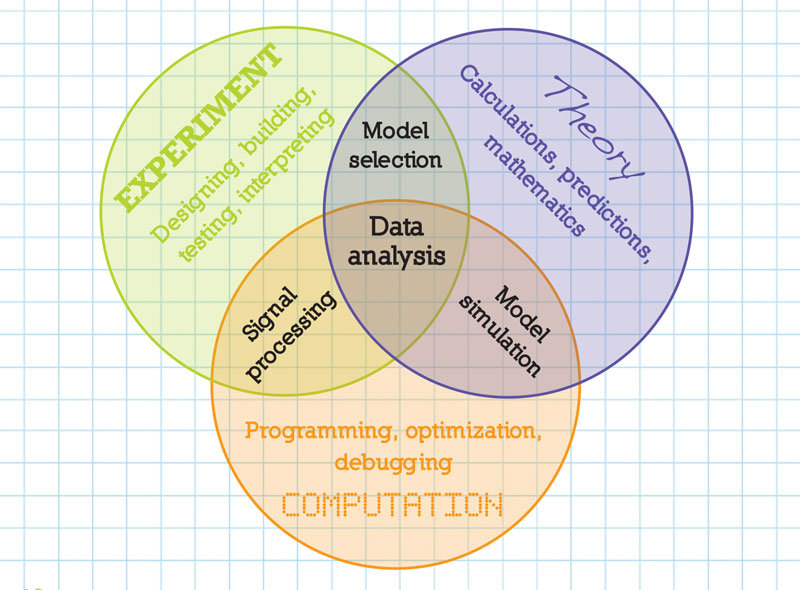From Theory to Experiment
Spring
2015
Special Feature
From Theory to Experiment
A view of the types of physics research
By:Jess McIver, Graduate Student, University of Massachusetts Amherst
University of Massachusetts-Amherst

Physics research can usually be classified as theory, experiment, computation, or somewhere in between. Each type of research has its own challenges and rewards.
Theory
Theorists use mathematics and models to explain current phenomena, predict new ones, and describe the laws of the universe. Often these researchers tackle specific problems limited in scope, such as modeling nuanced particle interactions or predicting the amplitude of gravitational waves propogating from shortly after the big bang.
Experiment
Experimentalists test theoretical predictions as well as investigate observable interactions and physical behavior. This generally involves constructing and operating instrumentation used for measurement or observation, on a scale from the rather small (equipment that fits easily inside a small room) to the very large (e.g., the Large Hadron Collider, which has a 27-km circumference). Experimental physics often leads theory, as when a new unpredicted particle is discovered. Likewise, theory often leads experimental activities.
Computation
Computational physics is increasingly becoming a field unto itself. These researchers apply numerical analysis and other computational techniques to physics problems, including large-scale weather simulations, investigations of the properties of semiconductors, or models of protein folding. Computation has deep connections to both theory and experiment.
Introducing LIGO
The Laser Interferometer Gravitational-Wave Observatory (LIGO) is a great example of a project that draws on different types of physics. LIGO consists of two state-of-the-art interferometers, one in Hanford, Washington, and the other in Livingston, Louisiana. They are designed to measure gravitational waves, tiny perturbations in the fabric of space-time emitted by astrophysical events great distances away.
Using strain measured by LIGO’s giant Michelson interferometers, we should be able to reconstruct the signal of a passing gravitational wave created by, for example, a neutron star merger, a galactic supernova, or a pulsar. If detected, gravitational waves would be especially interesting for probing astrophysical objects and events that are difficult to observe via telescopes.
Experimental physicists from around the world design, test, and install the cutting-edge technology that makes the interferometers work, from optic cavities and coatings to systems that isolate the optics from the constantly moving ground. Reading out the data that LIGO produces, calibrating it correctly, transmitting it for immediate analysis, and storing it all for future use requires an enormous amount of computing power. To search for small signals in that noisy data, data analysts blend theory, experiment, and computation techniques to build algorithms that search for different types of gravitational-wave signals. An especially powerful method compares the data with gravitational-wave templates generated with known astrophysical models, supplied by theorists and computational theorists called numerical relativists. It’s an enormously complicated project with many different specialties.
The scientists of the LIGO Scientific Collaboration are a diverse group at different stages of their careers, based at institutions big and small, focusing on many types of physics research that are all integral to the goal of observing new astrophysics from gravitational waves. //
MORE INFORMATION
Learn more about LIGO at www.ligo.org.
Apply for the LIGO Summer Undergraduate Research Fellowship at www.ligo.caltech.edu/LIGO_web/students/SURF/.
